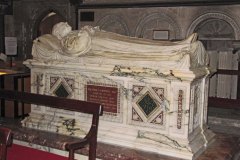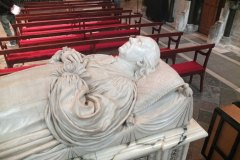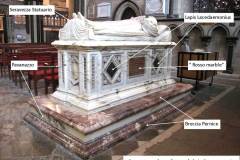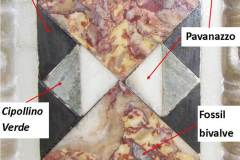Archbishop of Canterbury (1868-1882) – for more click here
Archibald Campbell Tait was born in Edinburgh and graduated with a first class at Oxford. During the reign of Queen Victoria he rose through the tiers of the Church of England and was consecrated Archbishop of Canterbury in 1868. After a period of indecision as to how and where in the cathedral he should be memorialised, in April 1884 the Dean and Chapter settled finally settled on a tomb chest with effigy located in the north east transept. This can be a rarely visited corner of the cathedral, but just a few paces off the normal tourist ambulation will bring you to the splendid freestanding tomb chest monument with reclining effigy, first revealed to the public in 1885.
The tomb monument was designed by John Oldrid Scott with the effigy carved by the sculptor Sir Joseph Edgar Boehm; the work is ‘signed’ at the foot of the effigy where the pall has been gathered: J.E. Boehm Fecit.
The tomb chest was constructed under the direction of William Brindley, a stone carver, of Farmer and Brindley, a partnership specialising in architectural sculpture and ornamentation.
Click on the images below to enlarge and read the captions.
The Builder, volume 50 (January to June 1886), records the types of stone used in the construction of the Archbishop’s tomb. Namely: ‘Seravezza marble’ (1), ‘Pavanazzo’ (2), Breccia (3), ‘deep-red Rosso marble’ (4) and ‘dark-green porphyry’ (5). Unfortunately the inlay marbles are not named in the article, but these are examined below following a description of the above five materials.
The principle marbles are identified below (1 to 5) followed by the inlay marbles (6 to 14).
The Principle Marbles
(1) Seravezza Statuario
The effigy of Archbishop Tait has been carved from a single block of exceptionally pure, translucent Seravezza Statuario. The stone is a metamorphosed limestone (i.e. a geological marble) with few impurities. Seravezza Statuario can often be visually indistinguishable from Carrara Marble
(2) Pavanazzo
The chest tomb itself is constructed of several pieces of grey-veined white marble. The white marble can be seen to be yellow-hued in places and the grey veining sometimes to be violet in coloration. These colour ranges are due to the different quantities of metallic oxides present. The name Pavanazzo is a descriptive name and derives from the Italian word for peacock (pavone). Pavanazzo is one of the many varieties of Carrara Marble.
(3) Breccia Pernice (the breccia)
A breccia is a rock consisting of angular or subangular fragments. It can be of sedimentary, igneous or deformational in origin. It is a generic term and does not assist much in identification of the stone’s provenance. The breccia referred to must be that which adorns the tomb plinth.
This tomb marble is composed of angular fragments ranging in colour from pink-white to deep-red-pink and is most likely to be the Lower Jurassic Italian breccia known as Breccia Pernice. Pernice is Italian for partridge and the stone’s colours were once considered to resemble the bird’s plumage. The rock fragments are all limestones of different hues depending on the quantity of iron oxide and iron hydroxide present. The material cementing the limestone blocks is also calcium carbonate. The quarries are located at Monte Pastello near Fumane in the Veneto.
(4) Rosso Antico (deep-red Rosso Marble)
The epitaph for the tomb was provided by the Dean of Llandaff and appears as letters of gold on a centrally located red marble side panels on the north side of the tomb. On the opposing side, in the same position, is a brief biography inscribed on an identical red marble (Figure 7). The ‘deep-red Rosso Marble’ is most likely to be the marble known as Rosso Antico from Greece. The stone came from the newly re-opened quarries on the Mani Peninsula on the southern coast of Greece. The stone is a true metamorphic marble having recrystalised from a marine limestone of Eocene age. The grains of calcite are coated with finely dispersed haematite (and manganese) giving the marble a hue that can range from pinky-red to purple.
(5) Lapis Lacedaemonius (the dark-green porphyry)
Four diamond-shaped side panels adorn the tomb made from a ‘dark-green porphyry’. A porphyry is any igneous rock which has large, well-formed crystals embedded in a fine-grained groundmass. This distinctive stone is Lapis Lacedaemonius from Krokeai (formerly Levetsova) near Sparta, Laconia, Greece, an igneous rock of Triassic age. There are large, sometimes clustrered, crystals of plagioclase feldspar and the minerals epidote and chlorite give the stone its green colour.
The Inlay Marbles
(6) Valencia Marble
There are a number of diamond-shaped pink-yellow marble inserts encircling the four pieces of Lapis Lacedaemonius and located on the end side panels. This marble is predominantly pink in colour with yellow undertones, more apparent on some inserts than others and through some pieces runs a deep-red veining. A stone that matches this description that was on the market in England in the late nineteenth century is Valencia Marble. It is a partially metamorphosed Upper Cretaceous limestone from the quarries of Barxeta (also known as Barcheta) and Quatretonda near Valencia in Spain.
(7) Cipollino Verde
This stone has been cut to form small diamond-shaped inserts and is most likely to be Cipollino Verde, a true geological marble with a large-scale green and white banding. The marble is named cipollino from its resemblance to a cut onion (cipolla). The stone comes from the southern flanks of Mt Ochi, near Karystos, on the Greek island of Euboea. The green banding is a result of impurities in the marble including the green minerals chlorite and epidote.
(8) Spanish Broccatello
Inlaid as diamonds in the eight corner panels of the tomb (Figure 11) and as alternating lozenges in the four triangular corner decorations to the Lapis Lacedaemonius panels is a marble of yellow, claret-red and blue-white hues. This stone is likely to be a Spanish Broccatello marble also known as Brocatelle d’Espagne. Broccatello is a reference to its resemblance to brocade (broccato) a richly decorated woven fabric with a raised design, often with gold threads. Spanish Broccatello is an Early Cretaceous limestone quarried near Tortosa in Catalonia, Spain. The stone is fossiliferous; tiny pieces of broken shell can be seen as white inclusions in some inserts.
(9) Giallo di Sienna
There are a number of small insets of a yellow marble, some lozenges and others as half-diamonds. This is likely to be Giallo di Siena a yellow marble from the Province of Siena in the Italian region Tuscany. The best quality stone is said to have been quarried at Montarrenti, near the town of Sovicille, not far from Sienna. The colour is derived from varying quantities of iron minerals present in the form of goethite and limonite. The marble is quarried from the Tuscan Metamorphic Complex, part of the Apennine Mountains.
(10) Verde Antico
A green, fragmentary marble can be seen as inserts in numerous locations around the tomb e.g. as small lozenges alternating with a yellow Giallo di Siena adjacent to the Rosso Antico inscriptions. This is strictly an ophicalcite breccia, a less precise rock tile would be a serpentinite. The rock forms from the metamorphism of magnesium-rich silicate rocks, such as a peridotite. Serpentinites and ophicalcite breccias are complex rocks and have a complex geological history.
(11) Marmo Pavonazzetto
There are a number of diamond-shaped pieces of a breccia composed of angular white marble fragments bound in a violet matrix located in two of the side panels of the tomb. This is Marmo Pavonazzetto, from Iscehisar in the province of Afyon , Turkey. As for the Pavanazzo, its name its name derives from Italian word for peacock (pavone). In 1885 William Brindley’s firm (the tomb’s constructors) were described as sole agents for the ‘pavonazzetto’ stone quarries, the same year in which Archbishop Tait’s tomb was unveiled. It is therefore hardly surprising that they used pieces of this marble for the tomb’s decoration.
(12) Pavanazzo
There are numerous triangular inserts on the monument as well as other architectural embellishments of white marble. The provenance of the white marble is difficult to determine from an inspection of the triangular inserts alone. However, the thin white marble bands encircling both the Rosso Antico panels and the Lapis Lacedaemonius panels clearly show a broad dark banding matching the principal constructional marble of the tomb. This suggests that the pure white triangular inlays are also selected pieces of Pavanazzo (see stone (3) above).
(13) Black Marble
Black marbles are notoriously difficult to identify; especially so from such small inserts. The stone could be Belgian Black Marble, a carbonaceous limestone of Devonian-Carboniferous age often referred to as Tournai Marble. In the alternative Derbyshire Black Marbles were frequently used as architectural elements and in domestic inlay work. There are also similar marbles from Kilkenny and Galway known collectively as Irish Black Marbles.
(14) Rosso Antico
There are several areas of red inlay marble identical to the stone of the two inscription plaques. See (4)above.




